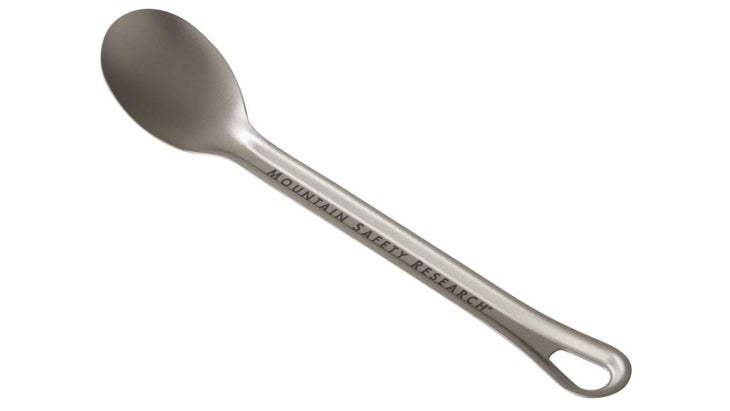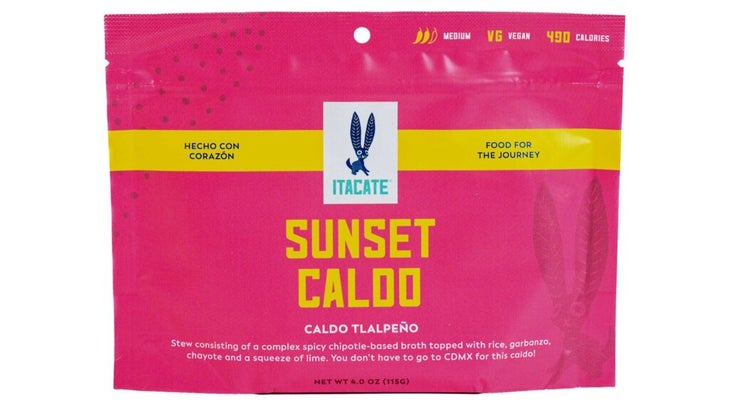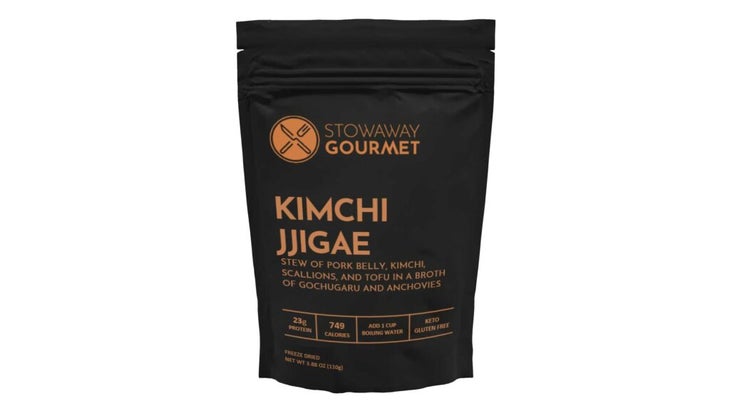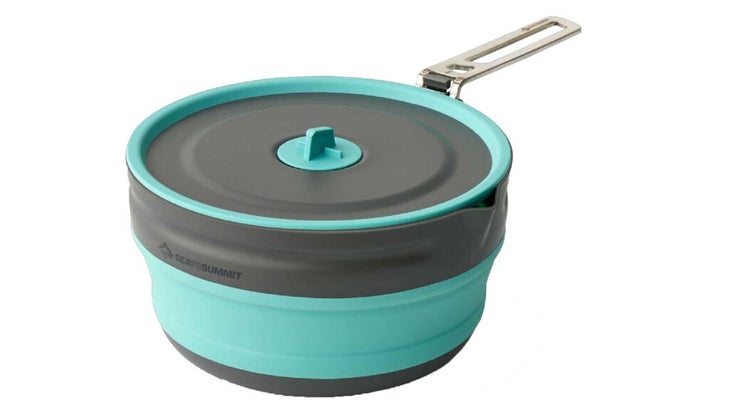Heading out the door? Read this article on the new Outside+ app available now on iOS devices for members! Download the app.
We all have our own ways of fueling in the backcountry. Whether you’re a gluttonous food snob (hand raise) or a minimalist nibbler, there are some things we can all agree on: everyone’s gotta eat. This summer, we slurped down cozy soups at sunset, wrapped up homemade trail snacks for summit picnics, made risotto from scratch, and crawled into our sleeping bags each night with full bellies and tired legs to bring you our favorite backpacking kitchen gear of the year.
At a Glance
- MSR Titan Long Spoon ($18)
- Itacate Sunset Caldo ($13)
- Stowaway Gourmet Kimchi Jjigae ($19)
- Sea to Summit Frontier Ultralight Collapsible Pouring Pot ($80)
- Bees Wrap Snack & Sandwich Bags ($15)
- How We Test
- Meet our Testers
All gear in this guide was tested by multiple reviewers. When you buy through our links, we may earn an affiliate commission. This supports our mission to get more people active and outside. We do not accept money for editorial gear reviews. Learn more.

MSR Titan Long Spoon
Pros and Cons
⊕ Ideal for deep pouches
⊕ Lightweight
⊕ Durable
⊗ Expensive for cutlery
Nobody likes grubbing around in the bottom of a greasy pouch for the last bite, only to have their hand coated in food gunk right before bed. Enter the MSR Titan Long Spoon, an 8.35-inch titanium spoon designed for mess-free deep-dives into hot mylar bags. Long spoons are nothing new, but this one wowed us with its durability after getting pummeled in our packs for months this summer.
“It was incredibly satisfying to be able to scrape every last morsel of food out of the pouch,” said one PNW-based tester on a 5-day hike on Mount Rainier National Park’s Wonderland Trail. Testers who preferred freshly-cooked meals to pouches found the Titan Long Spoon useful for stirring the contents of a hot soup or stew at a safe distance, too. We appreciated the small hole at the end for lashing to the outside of our packs when they were too crammed to fit even this 19-gram utensil into a side pocket.

Itacate Sunset Caldo pouch
$13 at REI $13 at Itacate Foods
Pros and Cons
⊕ Delicious
⊕ Fast rehydration time
⊗ Light on calories
A vegan take on the beloved Mexico City-born soup, Itacate’s rendition sated our testers with an impressive mix of traditional spices and vegetables. The Sacramento-based brand is a newcomer to the dehydrated backpacking food space, but its authentic representation of Mexican cuisine in an otherwise homogeneous industry is already making waves. Case-in-point: This pouch meal is loaded with guajillo and chipotle peppers, epazote, and chayote squash—four ingredients we rarely see on the back of our dinner packaging.
The hearty rice and garbanzo-based stew packs 16-grams of protein per serving, with a moderately spicy heat level—just enough to warm you up when the evening chill sets in. “I like that they label the spice level on each meal, and that they have vegan options,” said one tester after a backpacking trip in northern Yellowstone. The single-serving pouch delivers 490 calories, which was perfect for a light dinner, but did leave a few hikers in search of a little more substance after a long day on the trail.

Stowaway Gourmet Kimchi Jjigae pouch
Pros and Cons
⊕ Delicious
⊕ Calorie-rich
⊗ Expensive
It shouldn’t be a shock to find one of Stowaway Gourmet’s dehydrated meals in our summer gear guide: The standout Oregon-based company won our coveted Editors’ Choice award for its entire line of pouches in 2023. This year’s addition? Kimchi Jjigae, an ear-warming Korean stew originally invented to make use of extra-funky kimchi that was on its way out. Stowaway’s version is the real deal, with hunks of rich pork belly and tender cubes of tofu simmered in an unctuous broth that’s part Gochugaru chile heat, part hedonic meat broth.
The most startling thing about this stew is its texture. Somehow, Stowaway has managed to dehydrate kimchi—essentially a spicy pickle—in such a way that it rehydrates with crunch, tang, and even a little fizz that tastes like it’s straight from the jar. If we could wolf down one meal after a brutal, calf-burning day of hiking, this jjigae would be it.

Sea to Summit Frontier Ultralight Collapsible Pouring Pot
Pros and Cons
⊕ Easy to pack
⊕ Lightweight
⊗ Expensive
Whether boiling water or cheffing up a “real” meal, we found the all-new Frontier Ultralight Collapsible Pouring Pot to be the perfect balance of packability and cooking capacity. The Pouring Pot, like most cookware in Sea to Summit’s new line, uses a silicone and hard-anodized aluminum body with a thinner and more rigid construction that’s both stronger and lighter, coming in at 10.5 ounces. The 2.2-liter capacity was more than enough to heat up water for two or three dehydrated dinners at one time, and the convenient aluminum pouring spout kept our aim precise. A full handle—Sea to Summit’s old pots had just two side grips—makes it easy to dump water with one hand, with an aluminum lid that traps heat and won’t burn your hand thanks to a silicone tab handle.
One PNW tester used it to cook mushroom risotto from scratch, and was impressed with the even heat distribution in the ceramic-coated alloy base, which made for a delicious slow-cooked dinner on part of the PCT. Best of all? It packs down to the thickness of a slim paperback novel. “A pot is usually the item I can never quite fit right in my pack, but being able to collapse and slide it in made packing so easy,” said one tester after a multi-day hike in Washington’s Alpine Lakes Wilderness.

Bees Wrap Snack & Sandwich Bags
$15 at Amazon $15 at Bees Wrap
Pros and Cons
⊕ Reusable
⊕ Protects fragile snacks
⊕ Lightweight
⊗ Bulkier than plastic
Anyone who spends time in the wilderness knows that single-use plastic bags are a major no-no. But you can’t have your snacks swimming around in your backpack like a mobile mouse buffet, either. We’ve been using Bee’s Wrap to bundle up PB&Js for years, but these sandwich bags (each order comes with two sizes) add much-needed structure to the storage medium. The wrap is made from plant-based, waxed cotton and stitched together on two sides. Stuff a handful of GORP in the 8 x 4.5-inch snack bag or a thick sandwich in the 8 x 6.5-inch bag, then fold the top flaps over to seal it up.
“Of all the reusable wrappers I’ve tried, these are the only ones that actually hold my food inside, since they cinch up similar to foil,” said one Seattle-based tester after wolfing down a juicy, thicker-than-thick turkey club at an alpine lake in the North Cascades. Empty, the bags are flat, low-profile, and can be manipulated into any shape. One tester cinched it neatly over a stack of pancakes for the ultimate alpine start trail fuel. Cleaning is effortless, as long as you avoid hot water, which melts off the wax.
How We Test
- Number of testers: 13
- Number of products tested: 48
- Vertical feet hiked: 43,000
- Burnt tongues: 3
- Bonks: 2
- Summits bagged: 11
We spent the summer testing backpacking kitchen gear in the rugged valleys of the Gros Ventre Wilderness in Wyoming, steep trails in Mount Rainier National Park, and sandy beaches on the Olympic Peninsula. Our thirteen testers, spanning in age from early 20s to late 50s, hit the trail in search of packable, durable, lightweight, unique, easy-to-use, and delicious products that made their lives infinitely easier (and more fun!) when it came to feeding and watering hangry hikers.
Meet Our Testers
Category manager Lily Ritter is a Jackson-based freelance writer in the outdoor industry who spends summers hiking, mountain biking, trail running, and camping in the Tetons and Cascade Mountains. For the co-author of Beyond Skid: A Cookbook For Ski Bums, eating outside is (almost) as important as playing outside, so putting camp kitchen gear to the test in the field is the perfect marriage of food and adventure.
Benjamin Tepler is Outside’s senior gear editor in charge of all things hiking, backpacking, and car camping. A former food critic and professional cook, he takes his backcountry dining experience very seriously.